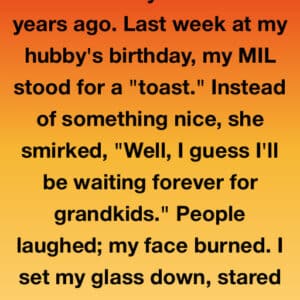A Mother’s Pain Was Misread for Years — Until a Sudden Collapse Revealed the Truth
Michelle Hughes began experiencing pain beneath her rib during her first pregnancy in 2016. At the time, doctors assumed it was a normal part of carrying a child. What none of them realized was that something far more dangerous was quietly growing inside her.
“It was just a nagging ache, not sharp enough to be alarming,”
Michelle recalled. An ultrasound showed a benign liver hemangioma, and the concern ended there. She welcomed her daughter, Juliet, and focused on motherhood, despite the lingering discomfort.
As the years passed, Michelle had two more children—Adeline and Hatton. She juggled family life and a career as a social worker, while her mysterious rib pain continued. Occasionally, it sent her to the ER, but repeated scans assured her nothing was wrong.
That changed drastically in 2021.
Just days after Hatton’s premature birth, Michelle collapsed in front of her children. In the hospital, doctors were stunned: her lungs were riddled with tumors, and her liver was covered with cysts. Her heart rate was 180. Yet just weeks earlier, a scan had shown no change.
Transferred to Moncton for further testing, Michelle underwent a liver biopsy. She went alone, bringing only a breast pump, assuming she’d be home quickly. Instead, she began bleeding internally and was rushed to the ICU.
On August 20, 2021, a doctor delivered a life-altering diagnosis: Michelle had epithelioid hemangioendothelioma (EHE), a rare, incurable cancer. It had silently spread to her lungs, liver, and beyond—undetectable on standard ultrasounds for years.
Her family, devastated, asked the inevitable question: how long did she have?
There was a brief glimmer of hope. If the cancer was confined to her liver and lungs, a transplant might extend her life. But a PET scan crushed that possibility—tumors had reached her thigh and knee. The transplant was off the table.
A doctor told her bluntly that another EHE patient, with fewer tumors, had survived only months. Michelle, holding her newborn during the appointment, could only think:
“He’s never going to remember me.”
But another physician offered a different perspective.
A sarcoma expert in Toronto told Michelle something that changed her outlook: she had already lived with EHE for at least five years.
“You’ve given birth three times. You’ve survived a rupture. You’re still here. That means something.”
It was the first time anyone acknowledged the life she had already lived, rather than the death she was facing.
Michelle and her husband, Ty, decided to move from the Northwest Territories to Prince Edward Island to be closer to family. But after the move, Michelle caught what seemed like a cold. Within weeks, her condition deteriorated. Her doctor prescribed an oral cancer drug.
One sleepless night, while watching her son sleep, Michelle scrolled past a video of a bald woman doing a headstand—smiling despite her own Stage 4 diagnosis. Something clicked.
“If she can live like that, why can’t I?”
The next morning, Michelle stepped onto a treadmill. She walked, then jogged. She trained with a stroller, eventually running 5Ks and 10Ks, even pushing 170 pounds of her kids in a custom double stroller.
In 2024, on the third anniversary of her diagnosis, Michelle completed her boldest feat yet: a full triathlon. It included a two-kilometer ocean swim, 104 kilometers of cycling, and a half-marathon. She crossed the finish line with her children in her arms.
Her online journal, originally intended for her children, became a global inspiration. With over 400,000 Instagram followers, Michelle shares real, unfiltered moments—messy hair, raw emotions, and all.
“I always recommend we chase joy,”
she says.
“Even if it’s just for 30 seconds a day.”
Michelle has made peace with her diagnosis but remains focused on living—not dying. Her dream now is to watch Hatton get on the school bus for his first day of kindergarten. That day is just over a year away.
And she’s determined to be there, smiling at the curb.





